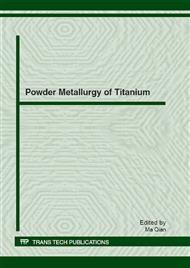p.281
p.289
p.295
p.301
p.309
p.314
p.320
p.330
p.335
The Effect of Laser Cladding Deposition Rate on Residual Stress Formation in Ti-6Al-4V Clad Layers
Abstract:
The effect of deposition rate on the residual stresses formed during the laser cladding of Ti-6Al-4V powder onto a Ti-6Al-4V substrate was investigated. To isolate the deposition rate from the heat input an analytical laser cladding model was employed to control the melt pool depth to 0.1mm. The clad height was also held constant by the model at 1mm. The laser traversing speed was varied between 300 and 1500 mm/min. The residual stresses were measured using the contour method and it was found that the distribution of residual stress was similar for the different deposition rates and that there was a small variation in the tensile stress level reached in the clad and heat affected zone (HAZ) layer. The microstructures for all three clad layers were a’ martensite and the size of the HAZ was consistent from sample to sample. It was concluded that residual stress development is independent of deposition speed for the laser cladding of Ti-6Al-4V.
Info:
Periodical:
Pages:
309-313
Citation:
Online since:
August 2012
Authors:
Keywords:
Price:
Сopyright:
© 2012 Trans Tech Publications Ltd. All Rights Reserved
Share:
Citation:


